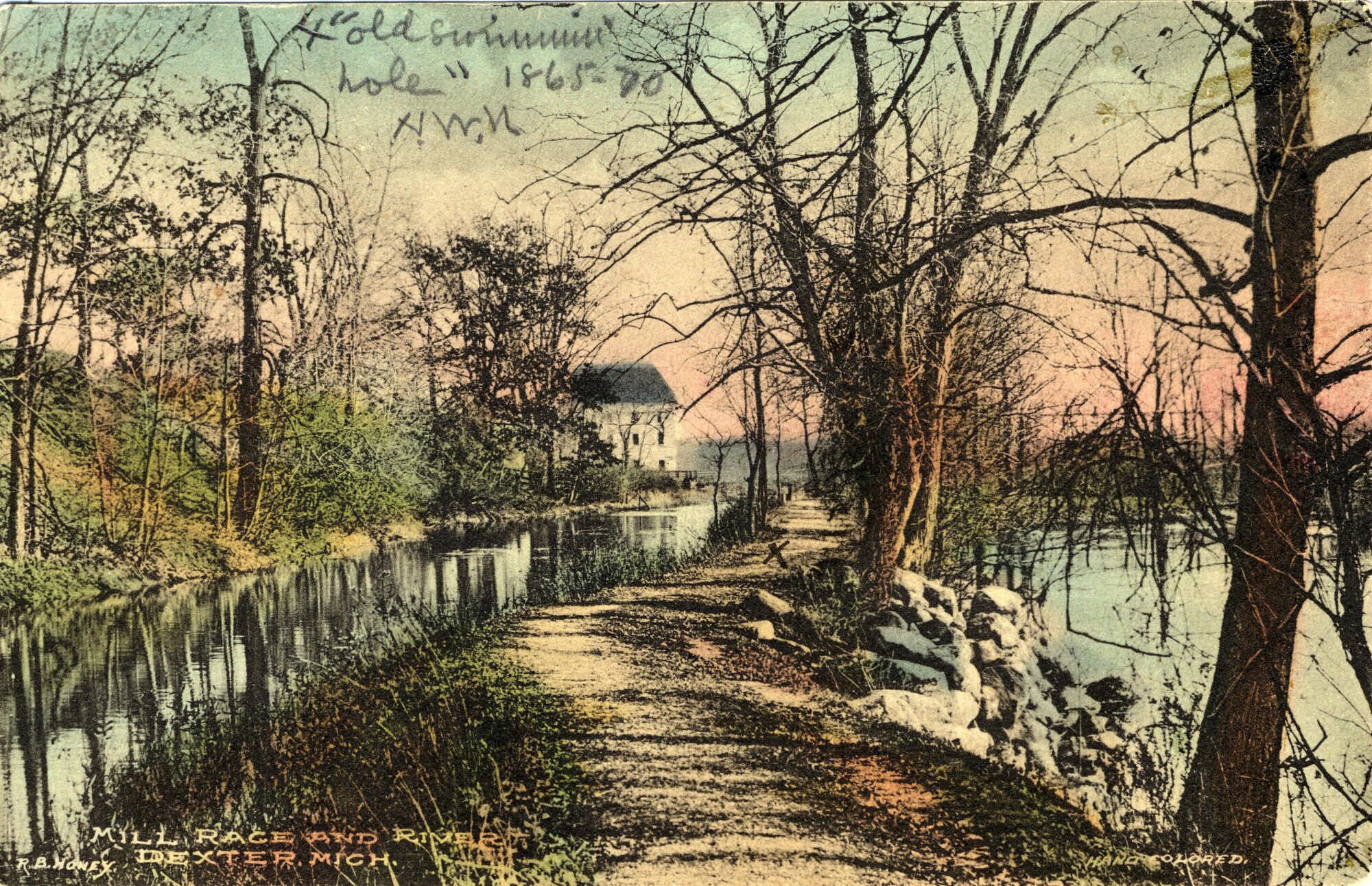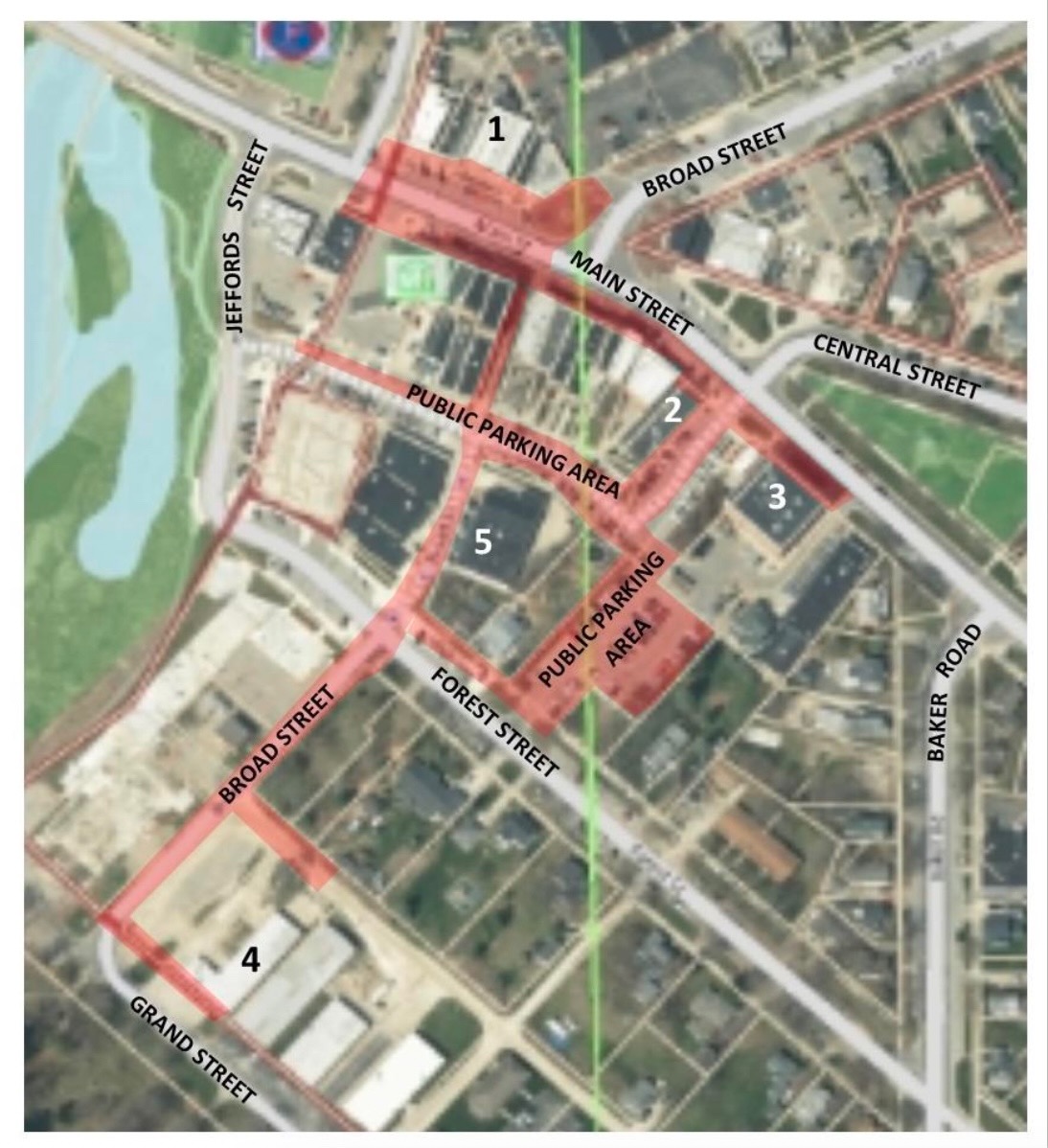The 1845 death that connected Dexter, Milan, and the death penalty
Photo: Colorized postcard photo of the Peninsula Mill. Courtesy of the University of Michigan Bently Historical Library.
The murder of Deforest Phelps by Sayer Reeves in 1845 reveals how economic transformations can upend lives, creating struggles and legacies that resonate far beyond their time.
The Circumstances Leading Up to Deforest Phelps’ Death
Sayer Reeves murdered twenty-three-year-old Deforest Phelps in the dark hours of the morning of May 2, 1845, outside of Dexter, near the Peninsula Mills.
The tragic events were rooted in a bitter conflict between economic development and personal grievances. At the center was the Peninsula flour mill in Dexter, Michigan, constructed by Jesse Millerd and his son George. Today, a blue party store sits at the five-point intersection of Huron River Dr., Joy Rd, and Mast Rd. where the mill once stood. The dam that powered the mill caused severe flooding on land claimed by Sayre Reeves.
As historian Danielle Roth described, “The dam had been ‘the theatre of much excitement’ for years, for it caused the river to overflow onto Reeves’s chosen building site each spring, resulting in rotting trees and waterborne diseases.”

Reeves had moved to Dexter in the 1830s with hopes of building a stable life for his family, but the mill’s construction turned his dreams into a nightmare. He sued the Millerds for $250 in 1843 and initially won damages, but the Millerds refused to pay. Frustration mounted as Reeves endured both economic loss and physical hardship.
According to Roth, “Reeves’s lawsuit had been tied up in appeals for a year, and he could wait no longer.” Reeves believed he had exhausted all legal avenues and decided to take matters into his own hands.
On the night of May 1, 1845, Reeves, joined by his brother-in-law Jonas Young, relative James Jacobus, and two others, embarked on a desperate mission to destroy the dam. Roth noted, “They arrived at the dam with their tools and commenced operations,” attempting to dismantle the structure that symbolized his suffering. Reeves and his companions had trenched around the dam weeks earlier, hoping spring rains would undermine it, but the dam held firm. This time, they sought a direct assault.
Meanwhile, twenty local farmers, including 23-year-old Deforest Phelps, organized to defend the mill. Mills were vital to rural economies. Roth explains that water-powered saws cut logs into lumber, grinders milled corn and wheat into flour, and looms made wool and cotton into cloth. Mills made it possible for farmers to sell their surplus grain as flour for export.
Roth writes, “Some settlers regarded mills as the means to uplift themselves from subsistence to commercial agricultural production. The water-powered machinery of the gristmill eliminated the backbreaking labor required by hand grinding.” The farmers considered the mill essential to their livelihoods and were determined to protect it at all costs.
As Reeves’s crew worked under the cover of darkness, the vigilantes waited for their moment. Roth’s account vividly captures the chaos: “Around midnight on Friday, May 2, 1845, they rushed forward to put a stop to the destruction. Deforest Phelps led the charge. Reeves had resolved to fire upon anyone who attempted to stop them. Reeves, held by this resolve, shot into the crowd and hit Phelps. A doctor was called to treat him, but Phelps died at the site. Reeves escaped into the dark and disposed of the gun in the mill race. However, the determined citizens followed him, and he was arrested before morning.”

Shifting Cultural Forces at Work
In her thesis, Roth delves into the possible mindset that drove Reeves to murder. As mentioned, the mill gave farmers the chance to sell their surplus to New England markets. The Peninsula Mill, like others, symbolized economic modernization for the Village of Dexter. A new culture of “individualism and competitive pursuit of wealth” was emerging. “Reeves murdered Deforest Phelps in part out of the frustration of being trapped in a larger, economic, legal, and cultural transformation occurring in southeastern Michigan,” Roth states.
Reeves was poor, barely able to avoid starvation. Perhaps a profound and overwhelming sense of being left behind in the growing wealth or feeling victimized by those getting rich provoked him to attack the most tangible element of his changing world—the mill and the people who supported it.
Roth writes, “In 1845, Dexter was a village in transition. A decade previous, Dexter was a small agricultural community without many outlets to the outside market. The residents of Dexter produced most of the goods they required themselves. Then, in 1841, the train flooded the small community with goods and people from the East and Europe. Suddenly, Dexter had a thriving business center, an accessible market for their produce and livestock, and the manufactured products from factories. Millerd was instrumental in bringing about this transformation. He traveled to the east to make contacts with merchants, sold manufactured products in his store, and helped sell agricultural produce to out-of-state markets.”
These economic forces may have exerted pressure on Reeves to take the action he did, but he and his family shouldn’t have been on the land in the first place. The Reeves were squatters. The spring tide flooding was why the parcel was vacant and unsettled. Nobody could live there. Judge Samuel Dexter owned the property. Judge Dexter anticipated the flooding and so kept it free of tenants, licensing it to the Millerds for flooding. The Millerds had a legal right to flood the land, the very land that Reeves unlawfully settled.
“Yet there was no evidence Judge Dexter attempted to move Reeves off his land,” writes Roth. “Perhaps as the patriarch of the community, Judge Dexter took pity on the Reeves family and allowed them to stay on his land without charge.”
Dexter’s generosity, however, may have played an inadvertent role in the tragic situation. According to the law of the day, squatters could gain the right to remain on the land if they held it for a specific time. Despite the swamp-like conditions, Reeves lived on the property for three years, eking out enough to avoid starvation.
Mills proliferated in the western expansion, Michigan included. Conflicts between mill owners and the farmers whose land they flooded abounded, setting specific precedents. Roth writes, “According to the common law, a farmer claiming damage to land could legally ‘abate the nuisance himself,’ even to the extent of tearing down the dam.”
According to the laws of the day, Reeves obtained the land by successfully squatting on it and had a legal precedent for removing the source of the flooding.

Controversial Arrest and Court Proceedings
Reeves was arrested hours after the shooting, but the legal proceedings that followed were fraught with controversy. He justified his actions as a last resort to protect his family from the dam’s devastating effects. Nonetheless, he was convicted in the circuit court. The Michigan Supreme Court later upheld the decision, though public opinion remained divided. Reeves’s supporters argued he was a victim of systemic neglect and injustice, while others saw him as a murderer who acted out of rage.
Reeves’s eventual release in the late 1840s allowed him to rebuild his life, but the memory of the tragedy lingered.
Death Penalty Debate in Michigan
The killing of Deforest Phelps sparked a debate over Michigan’s 1847 abolition of the death penalty. Two local newspapers, Ann Arbor’s Signal of Liberty and the Ypsilanti Sentinel, clashed on the issue. The Sentinel argued that removing the death penalty weakened public safety, claiming fear of execution could deter crimes. The Signal countered, criticizing the Sentinel’s logic that immediate execution of a prior murderer, Charles Chorr, might have prevented Phelps’s death.
Chorr was convicted of first-degree murder and sentenced to death by hanging—the only death sentence ever issued in Washtenaw County, for killing Patrick Dunn. He escaped jail before his hanging and was never found. The Reeves case highlighted systemic failures, reinforcing Michigan’s pioneering 1847 abolition of capital punishment—the first in the English-speaking world. Michigan’s last execution occurred in 1830, during its territorial era.

Epilogue for Sayre Reeves and the Dexter-Milan Connection
Following his release, Reeves relocated to Oakville, a small community five miles east of Milan, where his past was unknown. But life continued to be an uphill struggle for Reeves. In 1850, he moved to London, Michigan, a mile south of where the Milan Dragway is today, where he managed a hotel. After that, an 1870 census records that the man who fought the changing world by attacking a dam and killing Deforest Phelps ironically opened the Reeves Saw Mill, powered by steam not water, in Azalia a few miles west of London.
The Millerds ran the Peninsula Mill until 1855 when they sold it. The mill continued its operations until 1888. The building collapsed in 1910. When the mill closed, one Dexter resident commented that this was “the hardest blow ever struck Dexter.”
Over time, his descendants worked to erase any connection to the events in Dexter. Reeves’s daughter Mary later returned to Dexter as a teenager, where she met and married Charles Sill, nephew of Deforest Phelps. Their union united two families linked by tragedy.
Mary and Charles eventually settled in Milan, where they lived next to Reeves’s son William, who had become a successful businessman. The families maintained a cordial relationship, avoiding any mention of the past. Historian Martha Churchill recounted a revealing anecdote: “Adeline Reeves, William’s granddaughter, once whispered to a friend, ‘I think my grandpa killed somebody, but don’t tell anyone!’”
Legacy of a Forgotten Conflict
The death of Deforest Phelps highlights the profound struggles of Michigan’s shift from a subsistence economy to a market-driven one, not unlike the challenges many working-class individuals face today in adapting to economic change. Reeves’s story reveals the human cost of progress, as systemic forces pushed him into desperation. Despite the tragedy, the story reflects how systemic change can profoundly impact individuals, leaving a lasting legacy of adaptation and hardship.
Sources
“Murder at the Dexter, Michigan, Peninsula Mills Dam.” Danielle Roth. Eastern Michigan University Digital Commons.
“When a Milan-area family kept a dark secret.” Martha Churchill. The Monroe News. Aug. 2. 2020.
Signal of Liberty. May 5 & 19, 1845.
Ypsilanti Sentinel. May 7 & 28, 1845.
“A man, a mill, and a murder accusation.” TheFreeLibrary.com






 8123 Main St Suite 200 Dexter, MI 48130
8123 Main St Suite 200 Dexter, MI 48130


